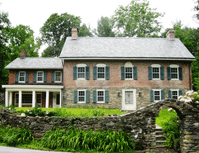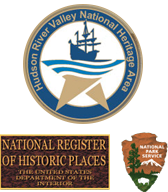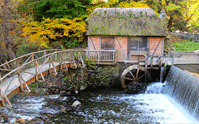The Starin Family
Residents from 1947-1984

 This
year we celebrated the fiftieth year of Mildred Starin’s
connection to Gomez Mill House. Mildred Starin and her husband
bought the house shortly after WW II. They raised four children
at the manor house. Mrs. Starin, an interior decorator and
antique buff, was also interested in the history of this old
house. This
year we celebrated the fiftieth year of Mildred Starin’s
connection to Gomez Mill House. Mildred Starin and her husband
bought the house shortly after WW II. They raised four children
at the manor house. Mrs. Starin, an interior decorator and
antique buff, was also interested in the history of this old
house.
Her initial study found that
the house was, indeed, the oldest house in Orange County,
New York. She found that the builder was a Sephardic Jew who
fled from Spain to find some liberty in France and then again
was persecuted and traveled to the Caribbean. From the islands,
Luis Gomez came to New York City. Further investigation uncovered
that this house was now the oldest Jewish residence extant
in America. Through Mrs. Starin’s efforts the house was
placed on the National Register.
Mrs. Starin contacted descendants
of the Gomez Family. The Goldstones were interested historians
who helped set up the Gomez Foundation for Mill House to spark
interest in the Jewish community for preservation. As Mrs.
Starin’s family began to leave the nest, overtures were
made by the Foundation to purchase the house. This was done
and in 1984 the house became the property of the Foundation.
Mrs. Starin remained on as resident manager, retiring in November
of 1996 from an active role. During this period she conducted
tours of the house by appointment only.
A unique feature was that
the numerous families who occupied the house either sold the
house furnished or left objects upon moving. Furniture and
personal artifacts were found in the outbuildings. The outbuildings
consisted of Hunter’s papermaking mill, a root cellar,
a building thought to have been slave’s quarters from
an early tradition and now used as a visitor’s center,
an ice house, a garage, tenant’s quarters and the full
attic in the main house. Mrs. Starin collected and restored
the objects and used them to complete the decoration of the
house. The provenance of some of the items was questioned
and Mrs. Starin contacted John C. Staples who lived in the
house prior to Hunter at the turn of the century and Dard
Hunter for more information. Unusual items such as a Spanish
manÇs armoire and chest from the middle 17th century
may have belonged to the original owner, Gomez. The Acker
family contributed the Bible Box that Wolfert used at his
meetings at the house. Chairs and cabinets known to have belonged
to the Armstrongs’ were found and documented. And items
crafted by Dard Hunter were identified by him on his visits
to the house. Two pieces signed by Hunter’s friend Gustav
Stickley were also found at the house. The items left by past
tenants and the objects purchased from or donated by Mrs.
Starin form the collection for this historic site. Using the
objects left in the house to teach and explain the lives of
the inhabitants from the founding of the area in 1714 through
today, one finds that the house is not one exhibiting a certain
period, but as Mrs. Starin often states, a house that has
been touched by history.
If it weren’t for Mrs.
Starin, there would be no celebration of any kind. Placing
the Gomez Mill House on the National Register of Historic
Houses and then saving it from the developer’s bulldozer,
of course preserved the house. Her talent for decorating and
restoration march along side of and with her preservationist
spirit. Without Mrs. Starin, there would be no Gomez Mill
House today.
Mrs. Starin has donated or
has left on loan at Gomez Mill House, many fine antiques that
she painstakingly restored that had been left by previous
owners. Without Mrs. Starin there would be few artifacts relating
to the past owners and certainly none with provenance.
The donations of furniture
and historical research that Mildred Starin has left with
Gomez Mill House make her a leading preservationist in the
Hudson River Valley and a very special lady.
|
Occupants of Mill House
Gomez
Luis Gomez, a Sephardic Jew, a merchant
and trader, was the first owner of Gomez Mill House, which
he built in Marlboro as a trading post for the new colonists.
Other pioneers, fleeing tyranny, and the cruelties in Europe
for the promise of a new life, then settled in the Hudson
Valley.
Acker
Wolfert Acker bought Mill
House In 1772 and added the elegant second story, which
was made from bricks baked in kilns on the property. He
was a member of the Ulster County Militia and fought during
the American Revolution to win freedom for the colonists.
Armstrong
When Harry Armstrong came
to Mill House in 1862 on his honeymoon he brought his southern
bride Maddie and stayed for the next 60 years. A gentleman
farmer, he added a new kitchen wing, and planted orchards
of fruit trees and berries to the property.
Hunter
Dard Hunter, legendary artisan
and craftsman bought Mill House in 1909. During his 7-year
residence, Hunter began his lifelong career in hand papermaking
and printing. He built a mill in the style of a Devonshire
cottage. There he experimented with hand milled paper and
produced his early signature work.
Gruening
America entered the war
in 1914, and the Hunter’s first son, Dard Jr., was
born a month later. Thinking he was going into the service,
Hunter sold Mill house in 1919. Hunter wrote in his autobiography
that the house was sold to a representative of the Russian
government and used as a school for children of all races.
He really sold to Ms. Martha Gruening who tried to establish
a Libertarian School at Mill House.
Starin
In 1947 the Starin family
purchased Mill House with a GI loan. They raised 4 children
here and were instrumental in preserving its heritage and
tradition. After much research and many years of persistence
Mildred Starin successfully placed the Gomez Mill House
on the Historic Register in January 1973.
Foundation
In 1984, the Gomez Foundation
purchased Mill House, which it administers and supports
today. The foundation board includes direct descendants
of the historic family owners and other dedicated to the
restoration and preservation of Mill House, and to the public’s
education of its historical significance. The museum staff
highlights 5 of the former owners in its presentation and
tours of this Hudson Valley treasure.
|






